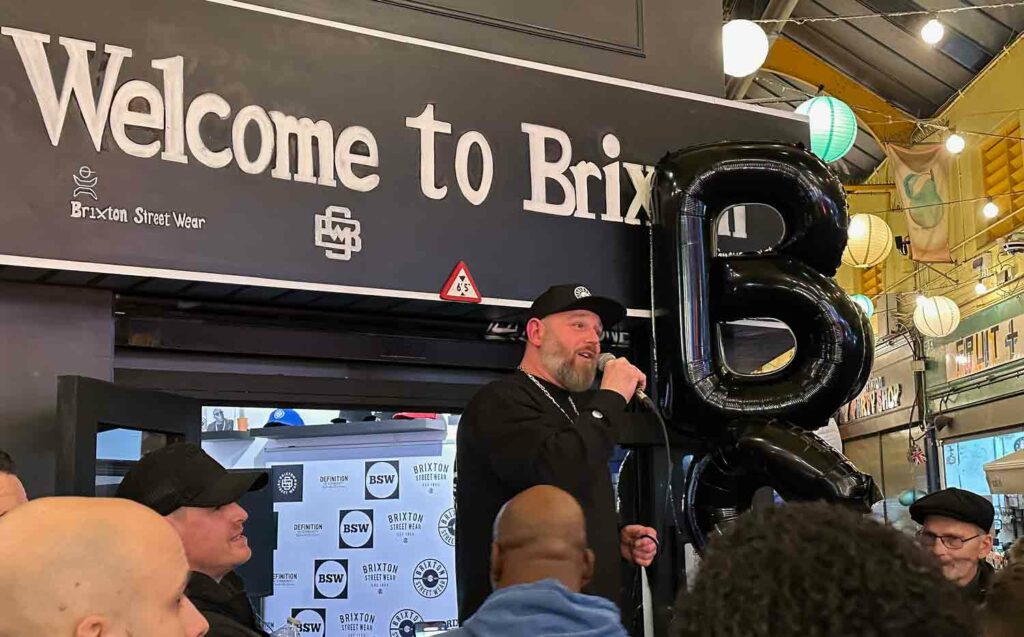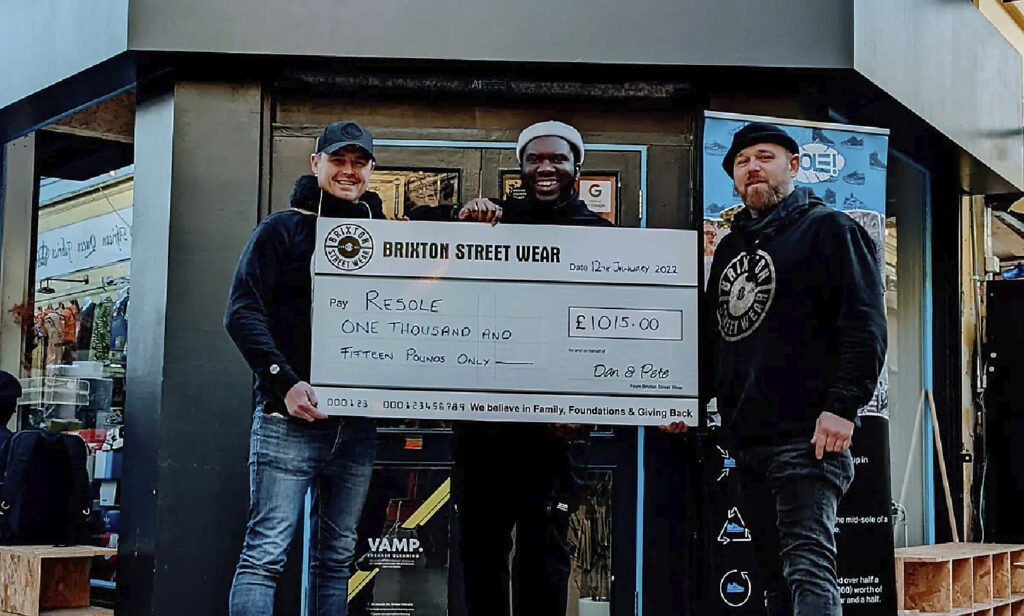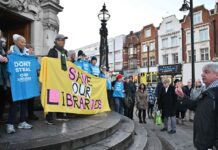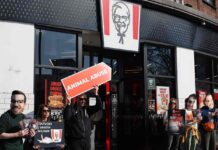
A large company based in Southern California is attempting to ruin a small community-based organisation in Brixton.
Brixton Street Wear, currently based in Brixton Market, tells what it sells through its name.
Launched in 2019 by Daniel O’Connell and Pete Adams, it celebrates the diversity and strength of Brixton.
The two London taxi-driver brothers’ brand sells products that champion Brixton as a community, and its profits go to the community, especially young people.
Brixton.com, official name Brixton LLC, is based in Oceanside, California, and was founded in 2004 by three men “who wanted to convey their lifestyle through unique products”.
It has more than 250 employees and a revenue of over $60m a year.
It is demanding that Brixton Street Wear hand over their name and hand over any profits they have made.
Pete Adams has started a Gofundme appeal to raise funds to pay for the massive legal bills associated with such cases.
It has already raised more than £4,500 towards a £20,000 target.
“This legal battle is about more than just a name – it’s about protecting the identity of Brixton and the businesses that call it home,” he said.
Our ethos is to “Give Back to our Community” by raising much needed funds for local projects and we want to be able to continue doing this.
The US company believe that no one can use the word “Brixton” except for them, “what a scary thought,” said Pete.
“Our brand name reflects not just our geographical location. but also our commitment to the people and businesses that make Brixton the vibrant place it is.
“We run our community hub from Brixton Village and we take no money ourselves from the shop, instead we rely on our income as London Taxi drivers.
“This ensures that all profit goes back to those that need it more than we do.
“We are reaching out to our community for support in this legal battle. We need to raise £20,000 to cover the costs of defending ourselves in court.
“If we do not reach our fundraising goal, all donations will be distributed among the local community and organisations that we work with, ensuring the funds still benefit the Brixton community.”
Pete said Brixton Streetwear has been an integral part of the local culture, collaborating with local artists, designers, and organisations.
“Our mission has always been to uplift and reflect the Brixton community, providing not just fashion but a platform for local talent and voices.”
He warned that the legal action could have an impact to other Brixton-based businesses and said it is not just about a name – “it’s about the identity and autonomy of Brixton as a community”.
If Brixton Street Wear was forced to change our name or cease operations, “it would set a dangerous precedent where local businesses could be silenced by larger, international corporations with no ties to our community”.
Pete called on the Brixton community, local government, and business networks to help the brothers fight their legal battle.

The Brixton Street Wear brand was created after Pete surprised his brother with a hoodie and hat for his birthday, both featuring a custom logo reflecting Daniel’s life.
Friends and Family saw these garments on Instagram, and several of them, as well as strangers, requested products of their own.
The demand became larger and larger, until the brothers decided to embark on the project as a unique business opportunity. Now, their brand sells much more than T-shirts and hoodies, including tracksuits, t-shirts, mugs, and much more.
From Brixton originally, Daniel and Pete’s family-owned business launch their Giving Back project each year, which seeks to fund and support projects in the Brixton area.
The brothers believe in the power of positive thinking, and treat everyone in the community as friends.
Over the years, their small business has launched several different fundraising campaigns, all with the hope of giving back to the community that they say has supported them over the years.
Their first fundraising project in 2020 raised over £800 for Brixton Street Gym, and their second raised £720 for Brixton Soup Kitchen with Lazy Scientist, a local business selling hot sauces.
They raised £1,015 in 2021 for Re:Sole, a charity that repurposes donates trainers and supports the homeless and refugees, and in 2022 collaborated with iconic pop artist, TBOY, raising £1,200 for a charity that runs local graffiti workshops and art projects for children in the Stockwell Hall of Fame.
In 2022, they also raised £400 for Mind Over Matter London, who use spoken-word to help people with their mental health.
The “Reverse Logo” campaign raised £600 for Mentivity, a charity that provides support for young people through mentoring.
In an Instagram post, Daniel said the brothers had not wanted to ask others for cash, but “we can’t financially support the legal fees for this”.
“I feel a bit choked,” he said. “We’ve come this far. We’ve done a lot of work. We’ve put a lot of work in, a lot of effort, a lot of groundwork, and people just come along and just try and take the name of your area where you live in a place that you’ve always loved.
“But if these things happen, and if we want great things to happen and succeed, we’ve got to put the effort in to keep it.”







This might help, it would appear that the Yank company might not have the rights to the name ‘Brixton’ wether they think they do or not.
Novagraaf specialise in this sort of issue apparently
https://www.novagraaf.com/en/insights/geographical-indicators-trademarks-and-place-names
Having looked at the California marketing it is arguable that they are on weak ground as they have been”passing off” their clothing brand as having a connection to Brixton, which it does not have.
It is common practice for companies to outspend in order to force smaller companies to buckle.
I had a similar situation and a good solicitor who advised minimal contact so the larger company had to do all the work and have all the costs.
We let it go to court, refused to respond to any correspondence and when it finally got to court the weakness of the case became obvious and I won. Costs accumulate hugely by engaging in dialogue between legal representatives.
Dont.
How dare the B. Y Yanks , can’t we counter sue after all our Brixton was first, the Californian one probably named after THE BRIXTON. Let’s boycott anything American including going their for holidays until they drop their ridiculous claim , greedy lot of trouble makers .
I suggest a less expensive course would be for Mr Adams and Mr O’Connell to raise this issue with their MP. There are UK restrictions on attempts to monopolize UK place names in commercial branding. I suggest you google “Geographical indicators: Trademarks and place names”. I think the UK Govt can step in and block this legal action.
Think the
UK government should intervene and tell the bloody yanks to **** *** and find an American ‘ brand’ name. Brixton UK preceded Brixton LCC. American bully boys
California have NO RIGHT to interfere with our ancient history. To educate your readers:- Until the mid-19th century
Brixton marks the rise from the marshes in the north of the ancient parish of Lambeth up to the hills of Upper Norwood and Streatham. At the time the River Effra flowed from its source in Upper Norwood through Herne Hill to Brixton. At Brixton the river was crossed by low bridges for Roman roads to the south coast, now Brixton Road and Clapham Road. The main roads were connected through a network of medieval country lanes, such as Acre Lane, Coldharbour Lane, Brixton Water Lane and Lyham Road, formerly Black Lane. It was only at the end of the 18th century that villages and settlements formed around Brixton, as the original woodland was gradually reduced until the area was covered in farmland and market gardens known for game and strawberries.[citation needed]
The area remained undeveloped until the beginning of the 19th century, the main settlements being near Stockwell, Brixton Hill and Coldharbour Lane. With the opening of Vauxhall Bridge in 1816, improved access to Central London led to a process of suburban development. The largest single development, and one of the last in suburban character, was Angell Town, laid out in the 1850s on the east side of Brixton Road, and so named after a family that owned land in Lambeth from the late 17th century until well into the 20th.[10] As bridges were built across the Thames in the early 19th century those working in the City of London and the West End moved to south London. The first development was in Washway, now Brixton Road. With the enclosing of the Manor of Lambeth, owned by the Archbishop of Canterbury, in 1806 and the opening of Vauxhall Bridge in 1816, terraced houses and detached villas started to line the main roads. The Rush Common enclosure stipulations dictated that houses had to be set back from the main roads, allowing for generous gardens. St Matthew’s Church on part of the former common land was consecrated in 1824. The parish of St Matthew Brixton, one of five subdivisions of the ancient Lambeth parish, stretched from Camberwell Green in the northeast, to Clapham Road in the northwest, to the outer edge of Brockwell Park in the southeast and to Kingswood Road in the southwest.[citation needed]
Ashby’s Mill, one of the few surviving windmills in London, was built in 1816, just off Brixton Hill and surrounded by houses built during Brixton’s Victorian expansion. The Surrey House of Correction, later Brixton prison, was established in 1819.[11]
As part of the Reform Act 1832 the expanding area of London was given representation with the creation of new parliamentary boroughs covering the metropolitan area. Only the part of Brixton north of St Matthew’s Church became part of the Lambeth parliamentary borough, reflecting the still semi-rural nature of the southern part of the area. The population of Brixton was 10,175 in 1841, about 10% of the parish of Lambeth. In twenty years the population of both had doubled.[12][13]